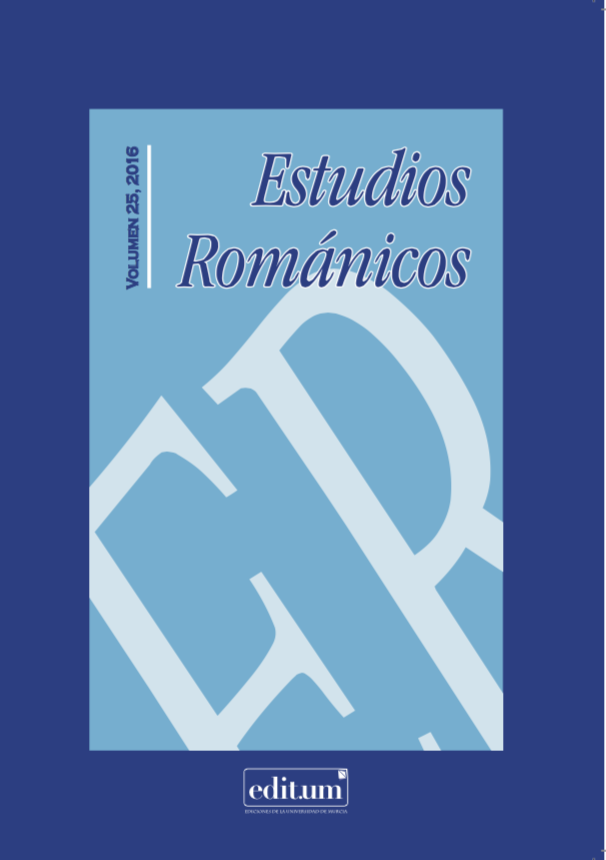What the use of the constructions con o sin mí and con o sin ti shows us about the language structure
Abstract
This paper centers around the disjunctive constructions con o sin mí and con o sin ti as alternatives to conmigo o sin mí and contigo o sin ti in Spanish, for the im- plications of their use for the subject of the compatibility between the preposition con and the personal pronouns mí and ti and, on a more general level, of the language value of these pronouns. Attention is drawn to the confirmation of a non-negligible number of cases of the former constructions, which may be considered “uncanonical”, due to the fact that, in them, con and the pronoun contract the same syntagmatic relation as in the now disused and frowned-upon constructions con mí and con ti. The apparent pa- radox is explained in terms of the Coserian distinction between system and norm, thus serving as an example to clarify the meaning and relevance of said distinction. Finally, the paper closes with some reflections on the way languages are historically constituted.
Downloads
-
Abstract1108
-
PDF (Español (España))243
-
PDF243
References
ALARCOS LLORACH, Emilio (1994): Gramática de la lengua española. Madrid: Espasa Calpe.
AZOFRA SIERRA, M.a Elena (2010): Morfosintaxis histórica del español: de la teoría a la práctica. Madrid: Universidad Nacional de Educación a Distancia.
AZPIAZU TORRES, Susana (2013): «El estilo de lengua. Antecedentes y fundamentos metodológicos», Dicienda. Cuadernos de filología hispánica. 31: 27-55.
BUENAFUENTES DE LA MATA, Cristina; PRAT SABATER, Marta; SÁNCHEZ LANCIS, Carlos (2015): Gramática histórica del español (morfología flexiva). Bellaterra: Universitat Autònoma de Barcelona.
CAMACHO, José (1999): «La coordinación», (Ignacio Bosque y Violeta Demonte, dirs.). Gramática descriptiva de la lengua española. Madrid: Espasa, vol. 2, 2635-2695.
COSERIU, Eugenio (1978): Sincronía, diacronía e historia: el problema del cambio lingüístico. Madrid: Gredos.
COSERIU, Eugenio (1982a): «Forma y sustancia en los sonidos del lenguaje». Teoría del lenguaje y lingüística general: cinco estudios. Madrid: Gredos, 115-234.
COSERIU, Eugenio (1982b): «Sistema, norma y habla». Teoría del lenguaje y lingüística general: cinco estudios. Madrid: Gredos, 11-113.
COSERIU, Eugenio (1983): «Linguistic change does not exist», Linguistica nuova ed antica. Revis- ta di linguistica classica medioevale e moderna. I: 51-63.
COSERIU, Eugenio (1995): «Principios de sintaxis functional», Moenia. 1: 11-46.
COSERIU, Eugenio (1996): El sistema verbal románico. México, D.F.: Siglo Veintiuno Editores.
DAVIES, Mark (2002): Corpus del Español. [http://www.corpusdelespanol.org; 26/02/2016].
DIEMER, Stefan (2011): «Corpus linguistics with Google?». Proceedings of ISLE 2 Boston (2008). [http://www.bu.edu/isle/files/2012/01/Stefan-Diemer-Corpus- Linguistics-with-Google.pdf; 26/02/2016].
DIETRICH, Wolf (1988): «Diachronie der Norm, Synchronie des Systems. Uber die Stabilität des grammatischen Systems der romanischen Sprachen». Energeia und Ergon. Das Sprachtheoretische Denken E. Coserius. Tubinga: Narr, vol. II, 172-182.
GAZDAR, Gerald; KLEIN, Ewan; PULLUM, Geoffrey; SAG, Ivan (1985): Genera- lized phrase structure grammar. Cambridge, Massachusetts: Harvard University Press.
GONZÁLEZ-VERGARA, Carlos; LABBÉ, Hernán (2010): «Unexpected case assignment and preposition doubling in pronoun coordination in Spanish», Southwest Journal of Linguistics. 29 (2): 55-73.
GILI GAYA, Samuel (1980): Curso superior de sintaxis española. Barcelona: Vox. GOOGLE (s. f.): s. t. [http://www.google.com; 26/02/2016].
HALLIDAY, M. A. K. (1961): «Categories of the theory of grammar», Word. 17: 241-292.
HANSSEN, Federico (1913): Gramática histórica de la lengua castellana. Halle: Max Niemeyer.
HARRIS, Zellig S. (1954): «Distributional structure», Word. X (23): 146-162. HJELMSLEV, Louis (1971): Prolegómenos a una teoría del lenguaje. Madrid: Gredos. JOHANNESSEN, Janne Bondi (1993): Coordination. A minimalist approach. Tesis doctoral, Oslo Universitetet i Oslo.
MOLTMANN, Friederike (1992): Coordination and comparatives. Tesis doctoral, Massachusetts Institute of Technology, Cambridge, Massachusetts. RABANALES, Ambrosio (1966): «Las funciones gramaticales», Boletín de filología. XVIII: 235-276.
RAE = REAL ACADEMIA ESPAÑOLA (1920): Gramática de la lengua castellana.
Madrid: Perlado, Páez y Compañía (Sucesores de Hernando), Impresores y Libreros de la Real Academia Española.
RAE (1973): Esbozo de una nueva gramática de la lengua española. Madrid: Espasa- Calpe.
RAE (s. f. a): Corpus Diacrónico del Español. [www.rae.es/recursos/banco-de-da- tos/corde; 26/02/2016].
RAE (s. f. b): Corpus de Referencia del Español Actual.[ http://www.rae.es/recursos/banco-de-datos/crea; 26/02/2016].
RAE y ASALE = REAL ACADEMIA ESPAÑOLA y ASOCIACIÓN DE ACADEMIAS DE LA LENGUA ESPAÑOLA (2009): Nueva gramática de la lengua española. Madrid: Espasa.
SAG, Ivan A.; GAZDAR, Gerald; WASOW, Thomas; WEISLER, Steven (1985):
«Coordination and how to distinguish categories», Natural Language and Linguistic Theory. 3: 117-171.
SATORRE GRAU, Fco. Javier (2002): «Revisión del sistema pronominal español», Revista de filología española. LXXXII (3-4): 345-380.
SAUSSURE, Ferdinand de (2005): Curso de lingüística general. Buenos Aires: Losada. TRUBETZKOY, Nicolai Sergeievich (1973): Principios de fonología. Madrid: Cincel. URRUTIA CÁRDENAS, Hernán; ÁLVAREZ ÁLVAREZ, Manuela (2001): Esquemas de morfosintaxis histórica del español. Bilbao: Universidad de Deusto.
TRUBETZKOY, Nicolai Sergeievich (1973): Principios de fonología. Madrid: Cincel. URRUTIA CÁRDENAS, Hernán;
ÁLVAREZ ÁLVAREZ, Manuela (2001): Esquemas de morfosintaxis histórica del español. Bilbao: Universidad de Deusto.
Las obras que se publican en esta revista están sujetas a los siguientes términos:
1. El Servicio de Publicaciones de la Universidad de Murcia (la editorial) conserva los derechos patrimoniales (copyright) de las obras publicadas, y favorece y permite la reutilización de las mismas bajo la licencia de uso indicada en el punto 2.
2. Las obras se publican en la edición electrónica de la revista bajo una licencia Creative Commons Reconocimiento-NoComercial-SinObraDerivada 3.0 España (texto legal). Se pueden copiar, usar, difundir, transmitir y exponer públicamente, siempre que: i) se cite la autoría y la fuente original de su publicación (revista, editorial y URL de la obra); ii) no se usen para fines comerciales; iii) se mencione la existencia y especificaciones de esta licencia de uso.
3. Condiciones de auto-archivo. Se permite y se anima a los autores a difundir electrónicamente las versiones pre-print (versión antes de ser evaluada) y/o post-print (versión evaluada y aceptada para su publicación) de sus obras antes de su publicación, ya que favorece su circulación y difusión más temprana y con ello un posible aumento en su citación y alcance entre la comunidad académica. Color RoMEO: verde.












